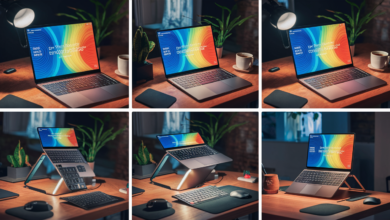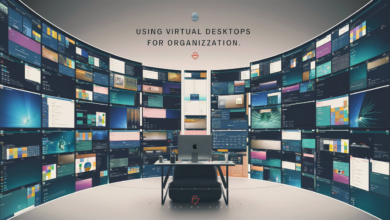Best Free Software for New Laptop Users

Starting with a new laptop is an exciting journey. The sleek design, the speed, and all that potential waiting to be unlocked can make anyone feel like they’ve just stepped into a world of endless possibilities. However, to truly harness that power, you need the right software. For many new users, navigating this landscape can be overwhelming. With so many options available—some paid and some free—it’s essential to choose wisely.
Free software not only helps you save money but also equips your laptop with tools for productivity, creativity, security, and fun. Whether you’re looking to streamline tasks or explore new hobbies, having the best free software at your fingertips is crucial for maximizing your experience on a new device. Let’s dive into some standout programs that will set you up for success in no time!
The top 5 free software for new laptop users
Starting with a fresh laptop can be exciting, but choosing the right software is crucial. Here are five free options that every new user should consider.
First up is **LibreOffice**. This powerful suite offers word processing, spreadsheets, and presentations without any cost. It’s an excellent alternative to Microsoft Office.
Next is **GIMP**, perfect for those venturing into graphic design or photo editing. It’s packed with features comparable to premium software.
For web browsing, **Mozilla Firefox** stands out with its speed and privacy-focused approach. Customizable add-ons enhance your online experience.
When it comes to security, **Avast Free Antivirus** provides reliable protection against malware while being user-friendly.
Don’t overlook **VLC Media Player**, which supports nearly all video formats and ensures smooth playback for entertainment on the go. Each of these tools will significantly improve your laptop’s functionality right from the start.
Benefits and features of each software
When it comes to free software for new laptop users, each option has unique features that can enhance your experience.
First up is **LibreOffice**. It offers a comprehensive suite of tools for word processing, spreadsheets, and presentations. Its compatibility with Microsoft Office files makes it a reliable choice.
Then there’s **GIMP**, an impressive image editing program comparable to Photoshop. With advanced features like layers and filters, you can unleash your creativity without spending a dime.
For browsing the web securely, **Mozilla Firefox** stands out with its privacy-focused approach and extensive library of add-ons. Customization options make it user-friendly while keeping your data safe.
On the productivity side, consider installing **Trello**. This project management tool helps organize tasks visually through boards and cards—perfect for keeping track of personal projects or team collaborations.
Don’t overlook **VLC Media Player**. It supports almost every audio and video format imaginable, ensuring you won’t run into playback issues anytime soon!
Step-by-step guide on how to download and install the software
Downloading and installing software is a straightforward process. Start by visiting the official website of the software you want. Look for a download button, usually prominently displayed.
Once you click that button, your browser will prompt you to save the file. Choose a location on your laptop where it’s easy to find, like the desktop or downloads folder.
After downloading, locate the file and double-click it to start installation. You might need administrative permissions; if prompted, choose “Yes.”
Follow the installation wizard carefully. It often asks about preferences such as language or directory path. Read through any agreements before proceeding.
Once installed, launch the application from your desktop or applications menu to begin exploring its features!
Tips for optimizing the performance of the software
To get the most out of your free software, start by regularly updating it. Developers frequently release updates that fix bugs and enhance performance.
Next, manage your startup programs. Disable any unnecessary applications that launch when you start your laptop. This helps to speed up boot times and reduce resource usage.
Consider adjusting settings within the software itself. Many applications allow you to customize features based on your preferences or needs, which can lead to better efficiency.
Regularly clear caches and temporary files too. This practice keeps the application running smoothly without being bogged down by accumulated data.
Familiarize yourself with keyboard shortcuts specific to each program. These can save time and streamline your workflow significantly, allowing for a more fluid user experience as you navigate through tasks.
Alternatives to free software options
While free software is an excellent option for new laptop users, there are alternatives worth considering. Paid software often comes with additional features and enhanced customer support that can be beneficial in the long run.
For example, if you require advanced editing tools, investing in a professional graphic design program might pay off. These applications generally offer more sophisticated capabilities than their free counterparts.
Another area to explore is subscription-based services. Many cloud storage providers offer premium plans that include added security features and larger storage options compared to free versions.
In some cases, open-source software presents a great balance between cost and functionality. Though not always as user-friendly as mainstream choices, they frequently provide robust performance without breaking the bank.
It’s crucial to assess your specific needs before making a decision on whether to stick with free options or invest in paid alternatives.
Conclusion: Making the most out of your new laptop with free, essential software
Having a new laptop opens up a world of possibilities. To truly unlock its potential, having the right software is key. The best free software for new laptop users can enhance productivity and make daily tasks easier.
By choosing the right applications, you can create a powerful workspace without spending a dime. Each of the recommended tools brings unique features that cater to various needs—from document creation to security protection.
Don’t forget about installation and optimization tips provided earlier; they will help ensure your software runs smoothly and efficiently. If you’re looking for alternatives or specific functionalities, there are many options available that might suit your preferences even better.
Taking advantage of these free resources not only saves money but also equips you with necessary skills and tools as you adapt to your new device. Embrace this opportunity to explore what’s out there—your laptop awaits!



